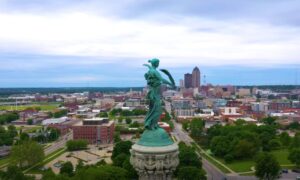Iowa has an enduring fascination with abandoned places. The state’s rural areas are filled with buildings that have long been left behind, providing a glimpse into its rich history.
Each abandoned building tells a story, acting as a time capsule of a bygone era.
However, exploring these places isn’t without its risks, both legally and in terms of safety.
Before you start your little adventure, enthusiasts should ensure they’re fully aware of the rules and precautions necessary to keep the experience safe.
1. The Art Building – Iowa City
- Location: University of Iowa, Iowa City
- Reason for Abandonment: After decades of use, the building’s infrastructure became outdated, and it was eventually closed.
- Current Status: The building is secured but has not been restored. Restoration plans have been discussed, though no final decision has been made.
- Significance: As the former workspace of Grant Wood, the building is not just a piece of architecture but a part of Iowa’s artistic legacy.
The Art Building at the University of Iowa, built in 1936, is a significant piece of the state’s artistic and cultural history. Designed with a blend of modernist architecture, it served as an academic and creative hub for artists for decades.
The building gained much of its fame as the workspace of Grant Wood, one of the most well-known American painters, whose iconic painting American Gothic became a symbol of rural American life.
Wood’s connection to the Art Building lends it a rich historical importance, making it not just another university facility but a crucial piece of Iowa’s artistic legacy.
Located on the campus of the University of Iowa, the Art Building holds an important place in the state’s artistic history.
2. Belle Plaine Train Station – Belle Plaine
- Location: Belle Plaine, Iowa
- Reason for Abandonment: With the decline of railway usage, the station fell out of use in the 20th century.
- Current Status: Privately owned, the station is undergoing some renovations, though much of it remains unused.
- Historical Significance: A reminder of Belle Plaine’s once-central role in regional rail transport.
Constructed in 1894, this train station was once a critical junction for the Chicago Northwestern Railway.
For decades, it served as a bustling transport hub, helping to shape the town’s economy and its place on the map. However, changes in transportation led to its decline.
Visitors should respect private property while admiring the historic structure from a distance.
There is another railroad locals are very well aware of.
3. Herring Hotel – Belle Plaine
- Location: Belle Plaine, Iowa
- Reason for Abandonment: Structural issues, particularly with the roof, have left the building in disrepair.
- Current Status: Currently owned by the city but in a state of uncertainty regarding restoration. The future of the building remains unclear.
- Significance: Listed on the National Register of Historic Places, the Herring Hotel stands as a fading reminder of Belle Plaine’s luxurious past.
The Herring Hotel, located in Belle Plaine, Iowa, was built in 1900 during the town’s economic peak and was once considered a symbol of grandeur and luxury.
With its ornate architecture and prominence in the local community, the hotel became a popular stopover for travelers and businessmen alike, offering accommodations that rivaled the finest hotels in the state.
It hosted grand events, gatherings, and banquets, solidifying its role as the social hub of Belle Plaine for decades.
4. Malek Theater – Independence
- Location: Independence, Iowa
- Reason for Abandonment: The rise of multiplex theaters and home entertainment options caused a decline in single-screen theaters like the Malek.
- Current Status: Efforts to restore the building have begun, and some sections have reopened to the public.
- Significance: A nostalgic reminder of the golden age of cinema in small-town Iowa.
Opened in 1946, the Malek Theater was once a vibrant entertainment venue, captivating audiences with its art deco style and movie screenings.
After being converted into a movie theater in 1985, it became a central part of the community’s entertainment landscape.
The Malek Theater’s restoration is a project of pride for the community, keeping its historical value intact while breathing new life into the venue.
5. Loucks Grove Church – Stuart
- Location: Stuart, Iowa
- Reason for Abandonment: The dwindling congregation led to the church’s closure.
- Current Status: While the structure remains intact, it suffers from vandalism and a lack of restoration efforts.
- Significance: Eligible for the National Register of Historic Places, this abandoned church is a symbol of rural decline and changing community dynamics.
Built in 1895, the Loucks Grove Church once served as a spiritual hub for the local community before it was closed in the late 1980s or early 1990s.
Its historical architecture and setting make it a hauntingly beautiful site, despite its current state of disrepair.
Explorers are urged to approach with respect, as the building’s cultural and historical value remains despite its neglected state.
6. Searsboro Consolidated School – Searsboro
- Location: Searsboro, Iowa
- Reason for Abandonment: The school was closed after the district was consolidated with neighboring towns in the mid-1990s.
- Current Status: Completely abandoned and in a significant state of disrepair.
- Significance: A haunting reminder of the shifting demographics and priorities in rural education.
Once a thriving educational center, the Searsboro Consolidated School was forced to shut its doors following the consolidation of the local school district.
Now in a state of disrepair, the building stands as a relic of an earlier era of education.
Due to its current condition, visitors are strongly advised to heed warning signs and avoid entering the building, which could be unsafe.
7. Waterloo Greyhound Park – Waterloo
- Location: Waterloo, Iowa
- Reason for Abandonment: Closed in 1996 due to bankruptcy and dwindling public interest in greyhound racing.
- Current Status: The site is largely unused, though some sections are employed for storage.
- Significance: A fascinating snapshot of Iowa’s brief foray into greyhound racing, now an eerie, untouched landmark.
Opened in 1986, Waterloo Greyhound Park enjoyed a brief period of success before closing its doors a decade later due to financial troubles.
Today, it remains largely untouched, offering a surreal and eerie atmosphere for those curious enough to explore its remnants.
Waterloo Greyhound Park is a prime example of how fleeting trends can leave lasting landmarks, even when they fall out of favor.
The Bottom Line
Iowa’s abandoned buildings are more than just relics of the past, they are snapshots of forgotten histories waiting to be rediscovered.
Each site tells a story, from the grandeur of once-thriving hotels to the quiet decay of former schools and theaters.
But as you set out to explore, always remember to tread carefully, respect these remnants of history, and follow safety and legal guidelines to ensure these fascinating landmarks remain preserved for future generations.














